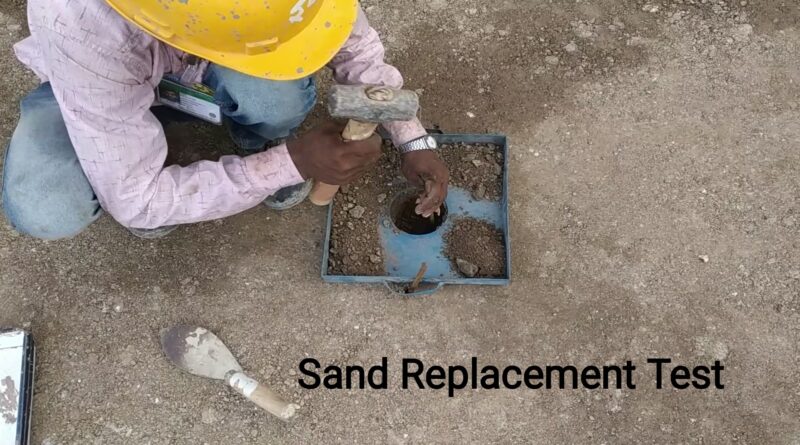Field Density Test of Soil by Sand Replacement Method.
Field density test of soil is conducted in the field to know whether the specified compaction is achieved or not. And main Objective of test is to determine the in situ density of natural or compacted soils using sand pouring cylinders.
The in situ density of natural soil is needed for the determination of bearing capacity of soils, for the purpose of stability analysis of slopes, for the determination of pressures on underlying strata for the calculation of settlement and the design of underground structures.
APPARATUS REQUIRED
- Sand pouring cylinder of 3 litre/16.5 litre capacity, mounted above a pouring come and separated by a shutter cover plate.
- Tools for excavating holes; suitable tools such as scraper tool to make a level surface.
- Cylindrical calibrating container with an internal diameter of 100 mm/200 mm and an internal depth of 150 mm/250 mm fitted with a flange 50 mm/75 mm wide and about 5 mm surrounding the open end.
- Balance to weigh unto an accuracy of 1 gm & 0.1 gm.
- Metal containers to collect excavated soil.
- Metal tray with 300 mm/450 mm square and 40 mm/50 mm deep with a 100 mm/200 mm diameter hole in the centre.
- Glass plate about 450 mm/600 mm square and 10mm thick.
- Clean, uniformly graded natural sand passing through 1.00 mm I.S.sieve and retained on the 600micron I.S.sieve. ( filled with uniformly graded sand passing through No. 20 sieve and retained on No. 30 sieve. ) It shall be free from organic matter and shall have been oven dried and exposed to atmospheric humidity.
- Suitable non-corrodible airtight containers.
- Thermostatically controlled oven with interior on non-corroding material to maintain the temperature between 1050C to 1100C.
- A dessicator with any desiccating agent other than sulphuric acid.
PROCEDURE
Step 1.
- Fill the sand pouring cylinder with clean sand so that the level of the sand in the cylinder is within about 10 mm from the top. Find out the initial weight of the cylinder plus sand (W1) and this weight should be maintained constant throughout the test for which the calibration is used.
- Allow the sand of volume equal to that of the calibrating container to run out of the cylinder by opening the shutter, close the shutter and place the cylinder on the glass sand takes place in the cylinder close the shutter and remove the cylinder carefully. Weigh the sand collected on the glass plate. Its weight(W2) gives the weight of sand filling the cone portion of the sand pouring cylinder.
- Repeat this step at least three times and take the mean weight (W2) Put the sand back into the sand pouring cylinder to have the same initial constant weight (W1)
- Determination of Bulk Density of Soil
- Determine the volume (V) of the container be filling it with water to the brim. Check this volume by calculating from the measured internal dimensions of the container.
- Place the sand poring cylinder centrally on yhe of the calibrating container making sure that constant weight (W1) is maintained. Open the shutter and permit the sand to run into the container. When no further movement of sand is seen close the shutter, remove the pouring cylinder and find its weight (W3).Determination of Dry Density of Soil In Place
- Approximately 60 sqcm of area of soil to be tested should be trimmed down to a level surface,approximately of the size of the container. Keep the metal tray on the level surface and excavate a circular hole of volume equal to that of the calibrating container. Collect all the excavated soil in the tray and find out the weight of the excavated soil (Ww). Remove the tray, and place the sand pouring cylinder filled to constant weight so that the base of the cylinder covers the hole concentrically. Open the shutter and permit the sand to run into the hole. Close the shutter when no further movement of the sand is seen. Remove the cylinder and determine its weight (W3).
Dry density
Step 2.
- Expose an area of about 450mm square on the surface of the soil mass. Trim the surface down to a level surface using a scrapper tool.
- Place the metal tray on the leveled surface.
- Excavate the soil though the central hole of the tray, using the hole in the tray as a pattern. The depth of the excavated hole should be about 150 mm.
- Collect all the excavated soil in a metal container, and determine the mass of the soil
- Remove the metal tray from the excavated hole.
- Fill the sand pouring cylinder within 10mm of its top. Determine its mass
- Place the cylinder directly over the excavated hole. Allow the sand to run out the cylinder by opening the shutter. Close the shutter when the hole is completely filled and no further movement of sand is observed.
- Remove the cylinder from the filled hole. Determine the mass of the cylinder
- Take a representative sample of the excavated soil. Determine its water content.

